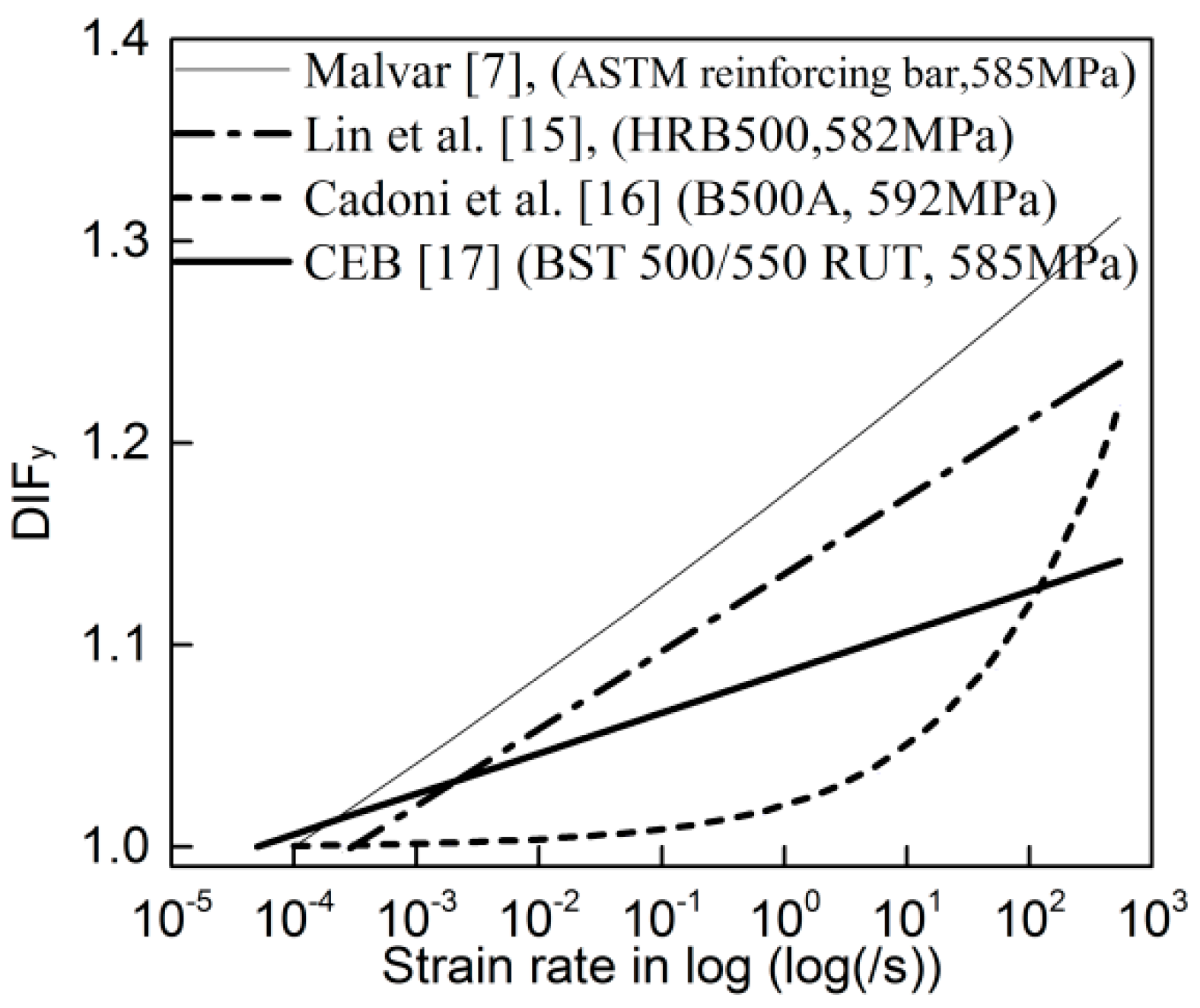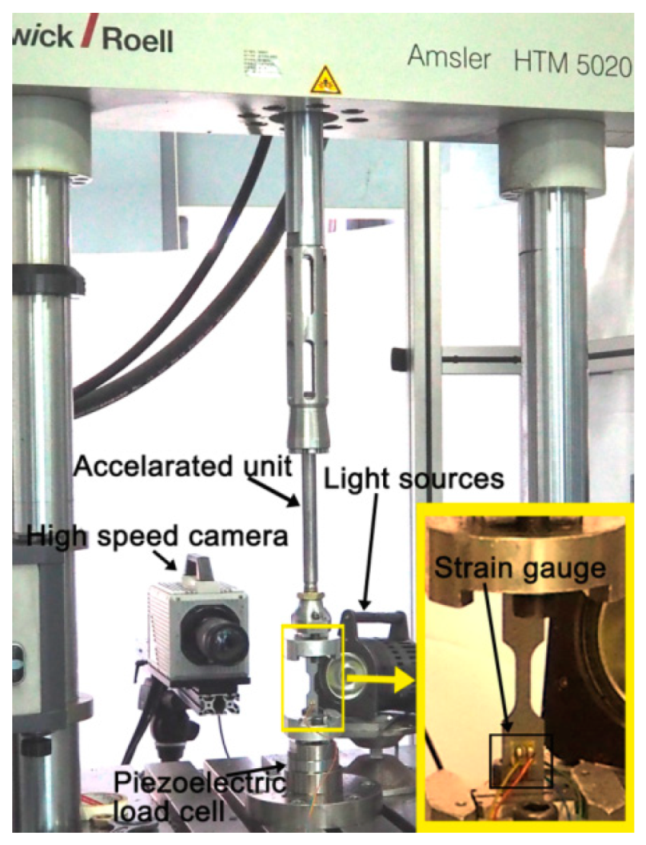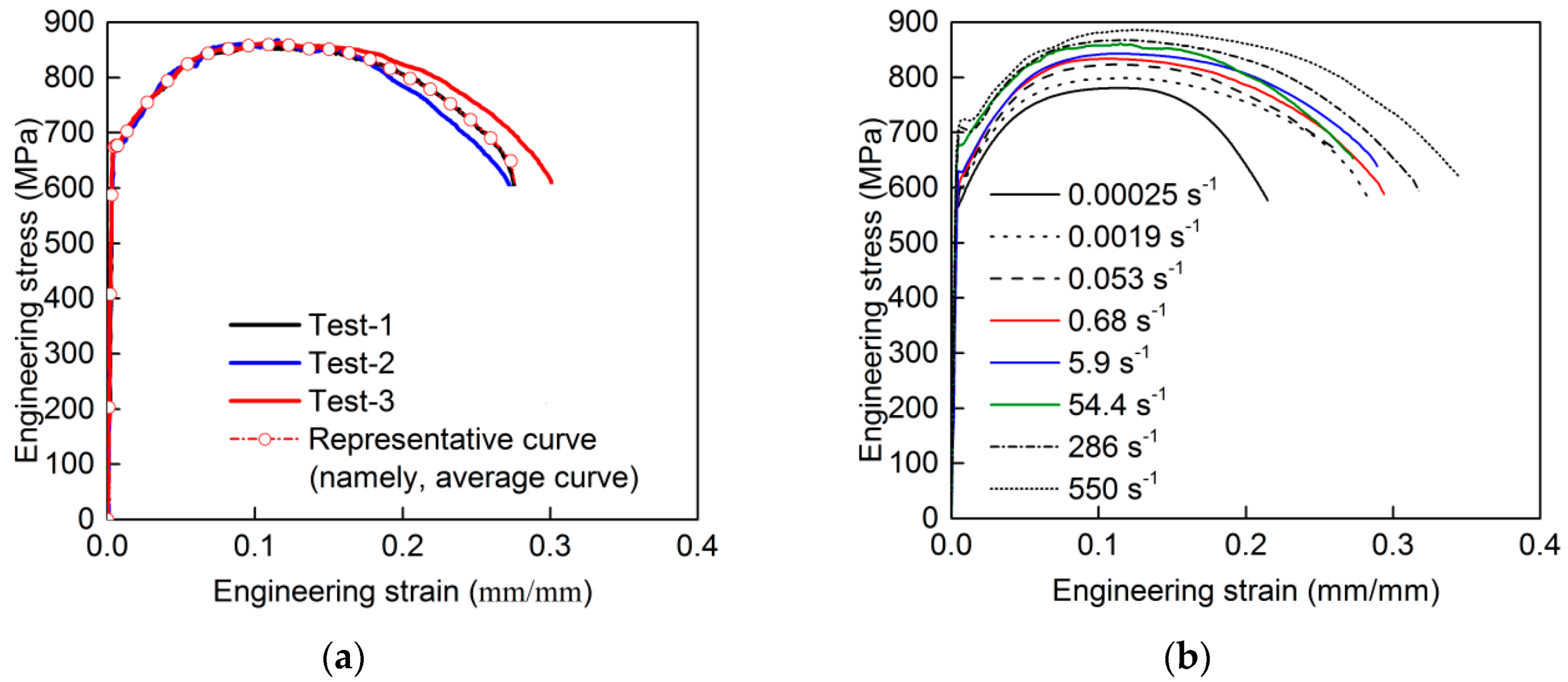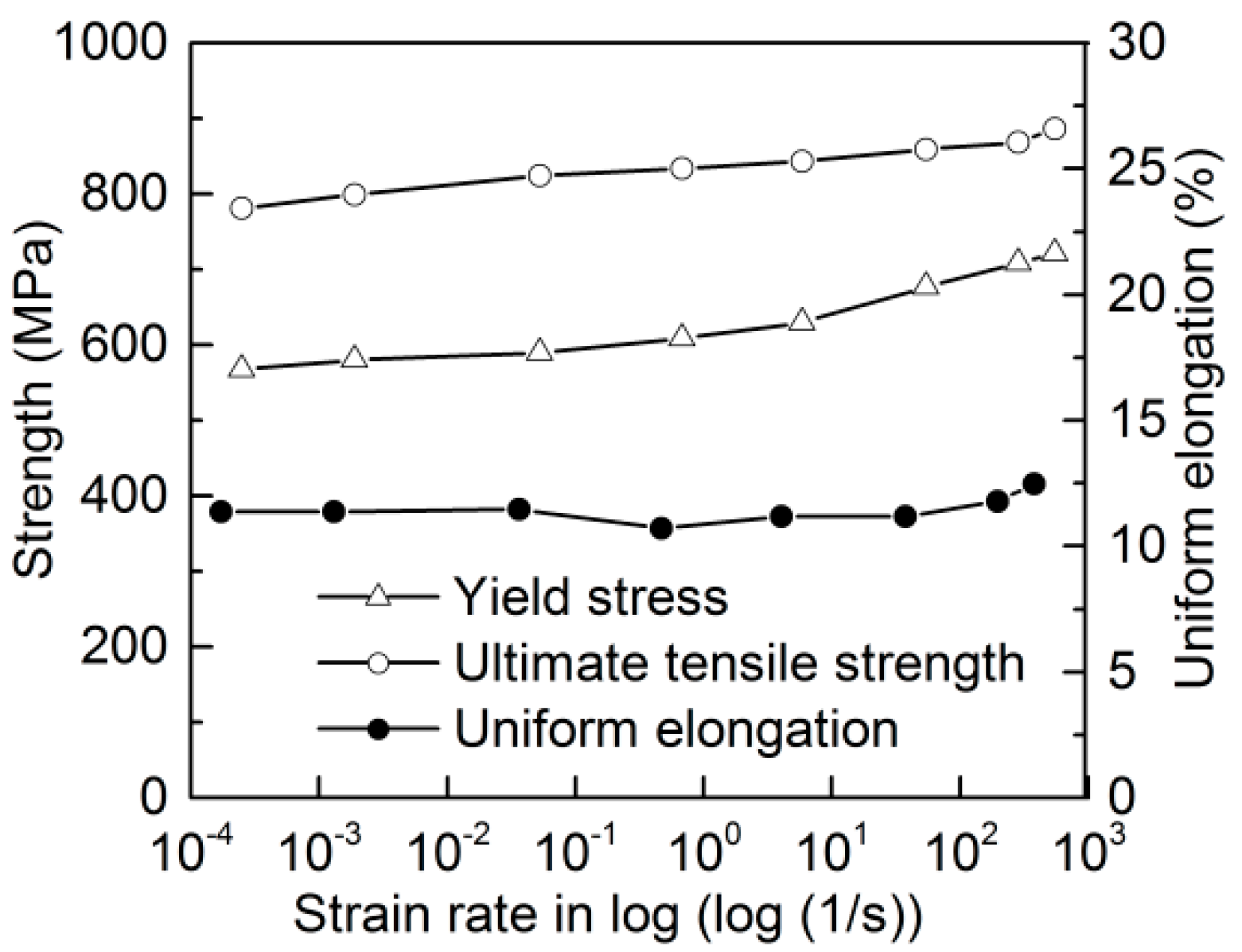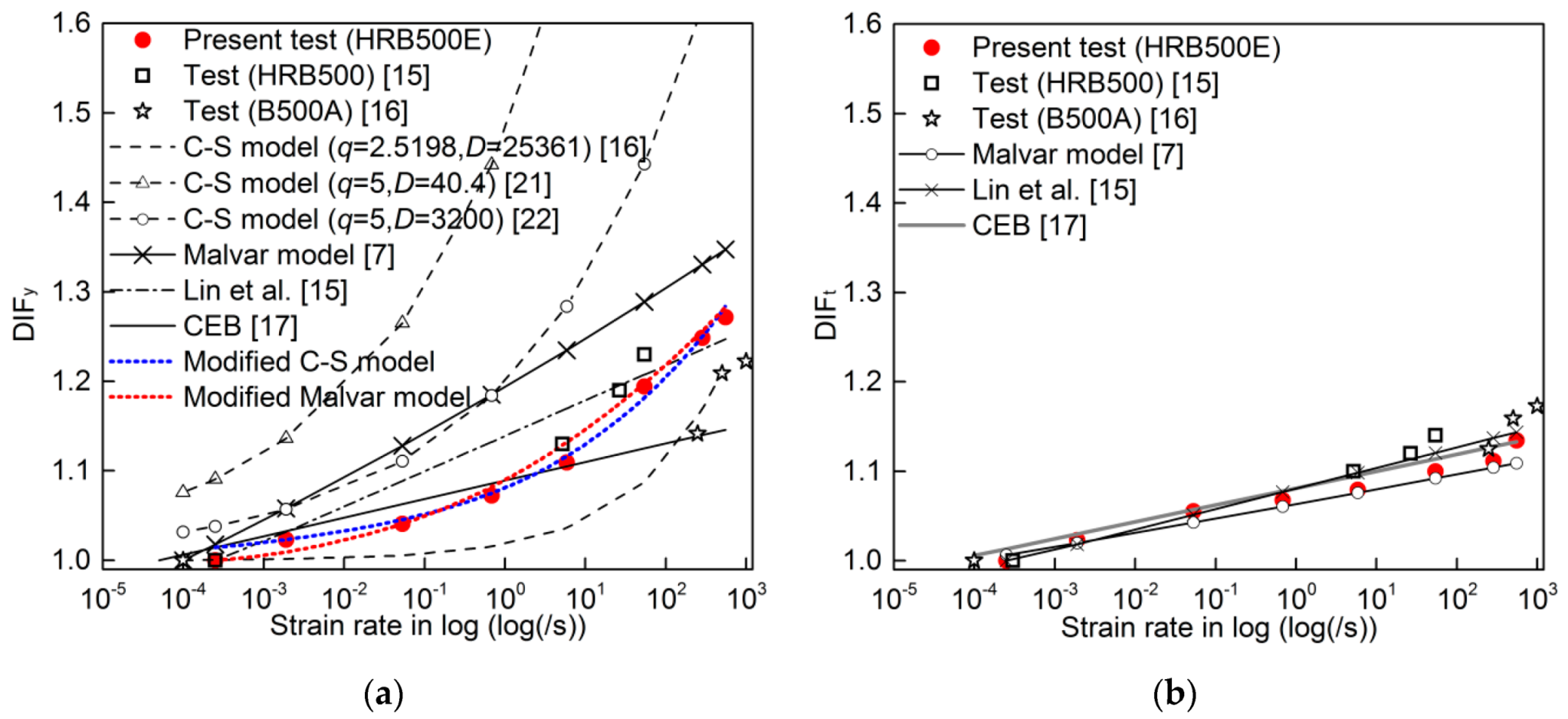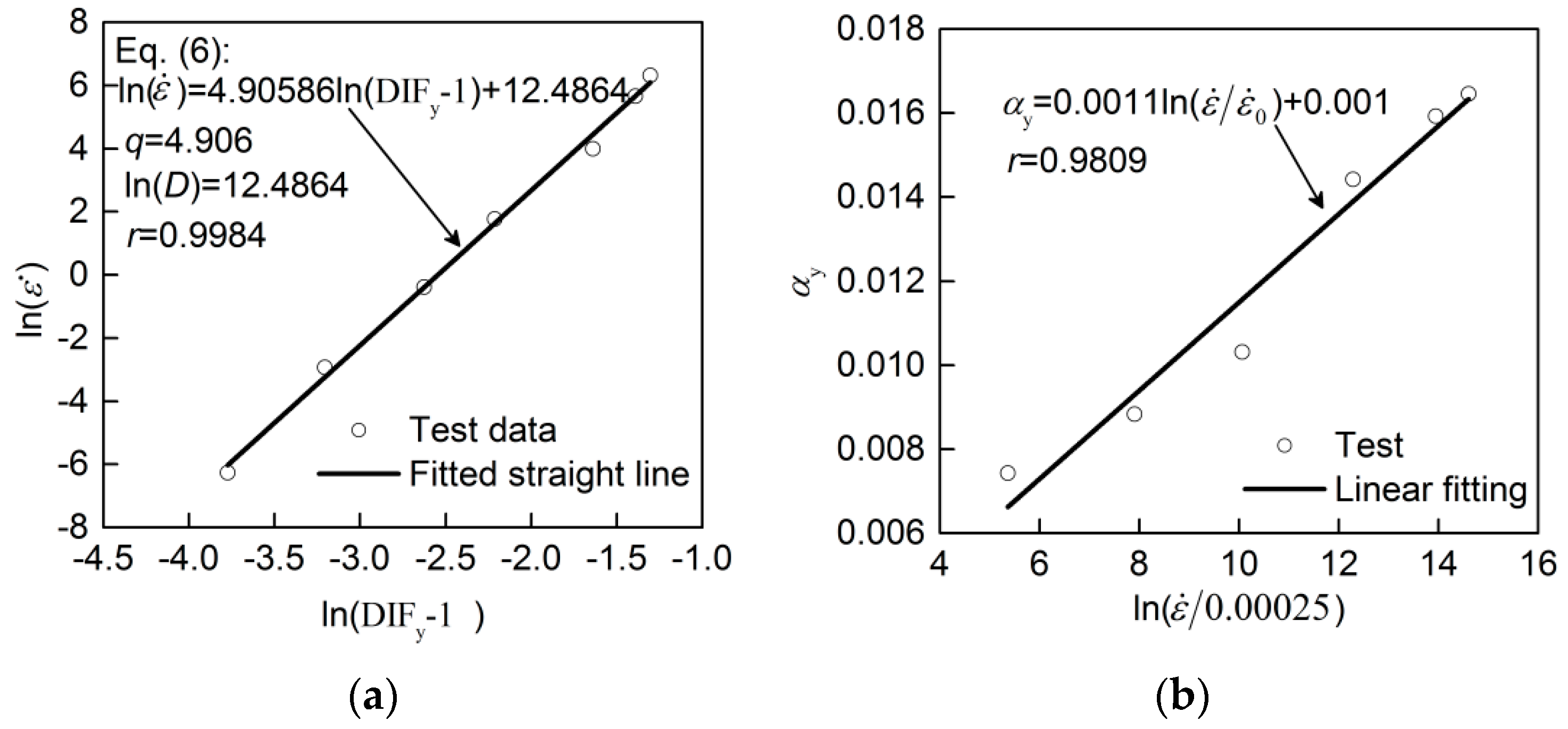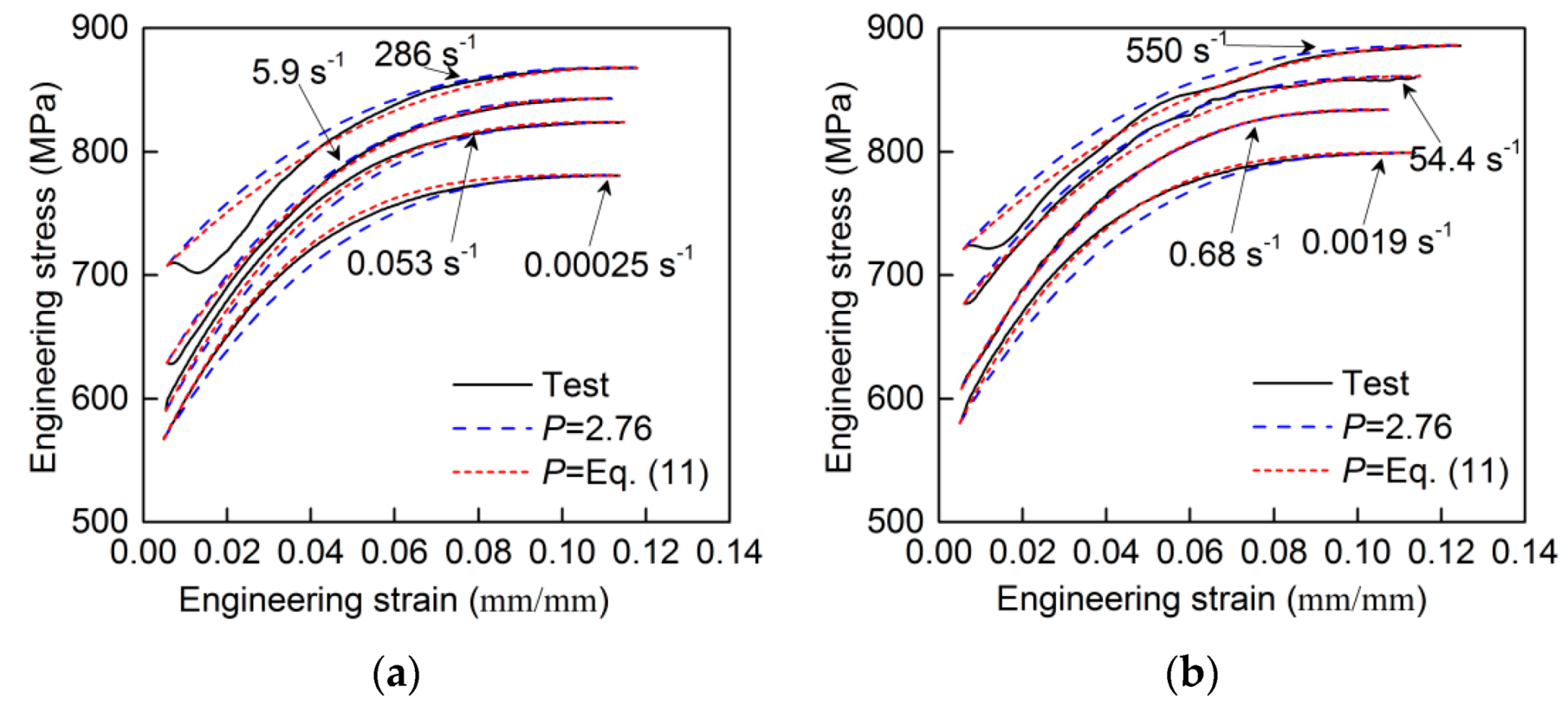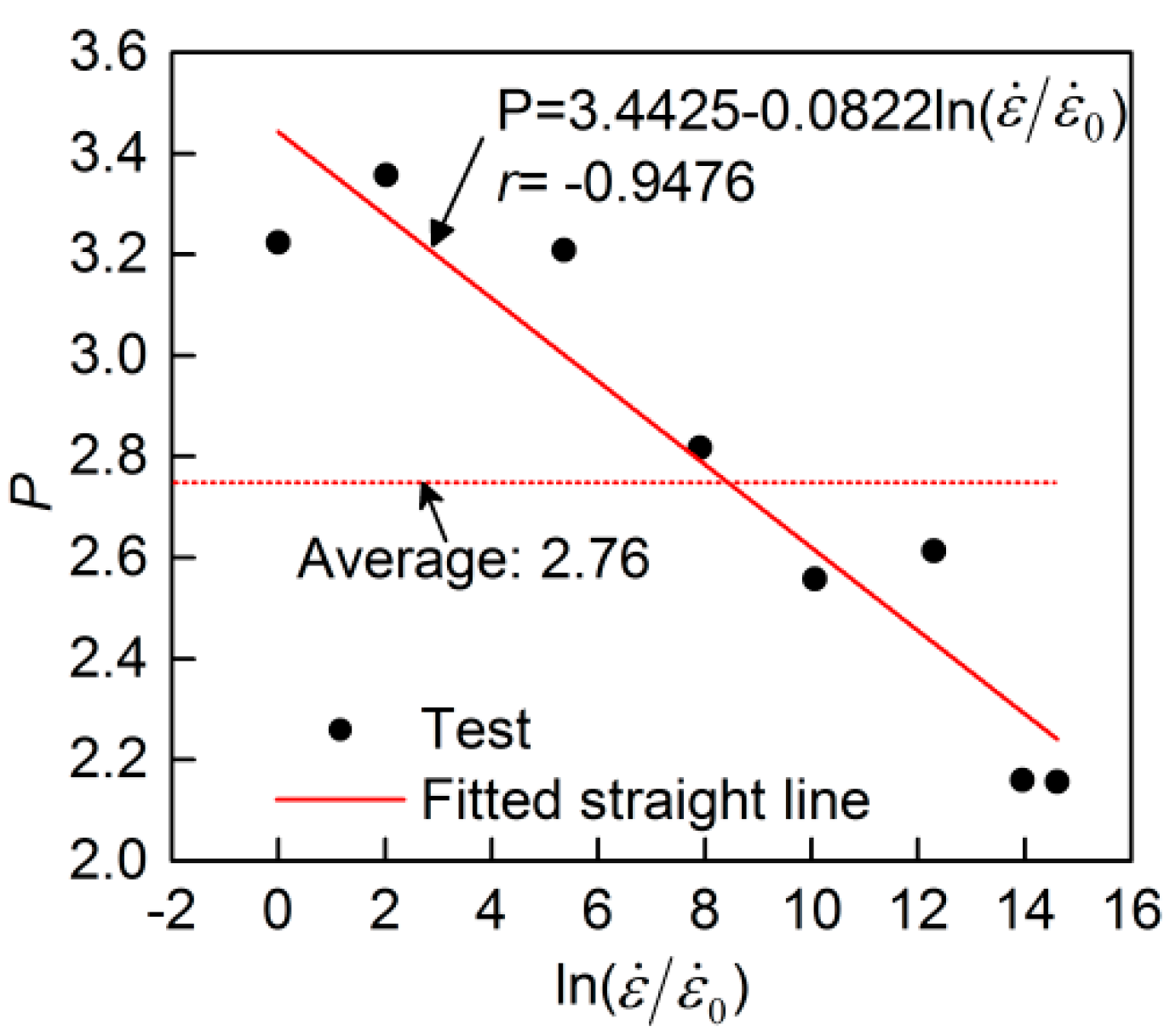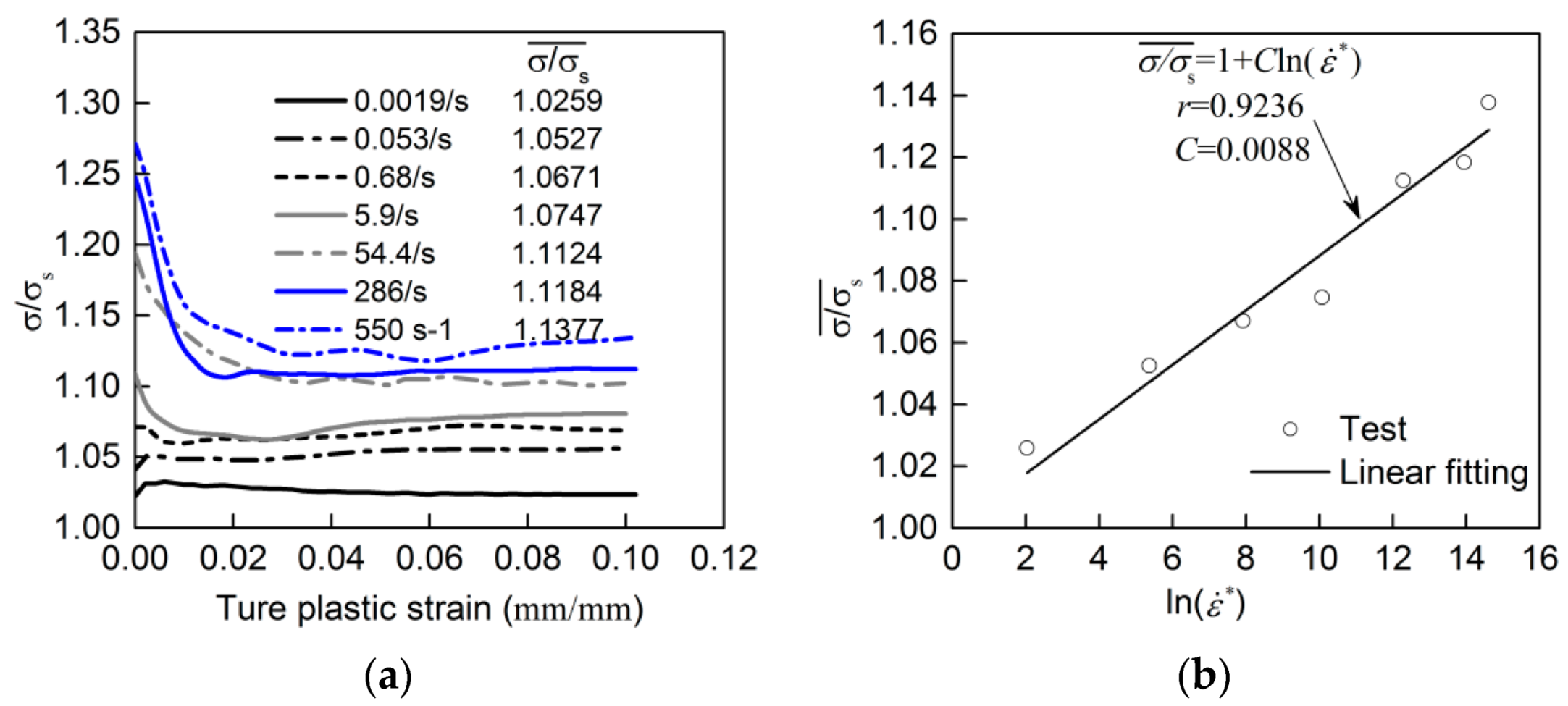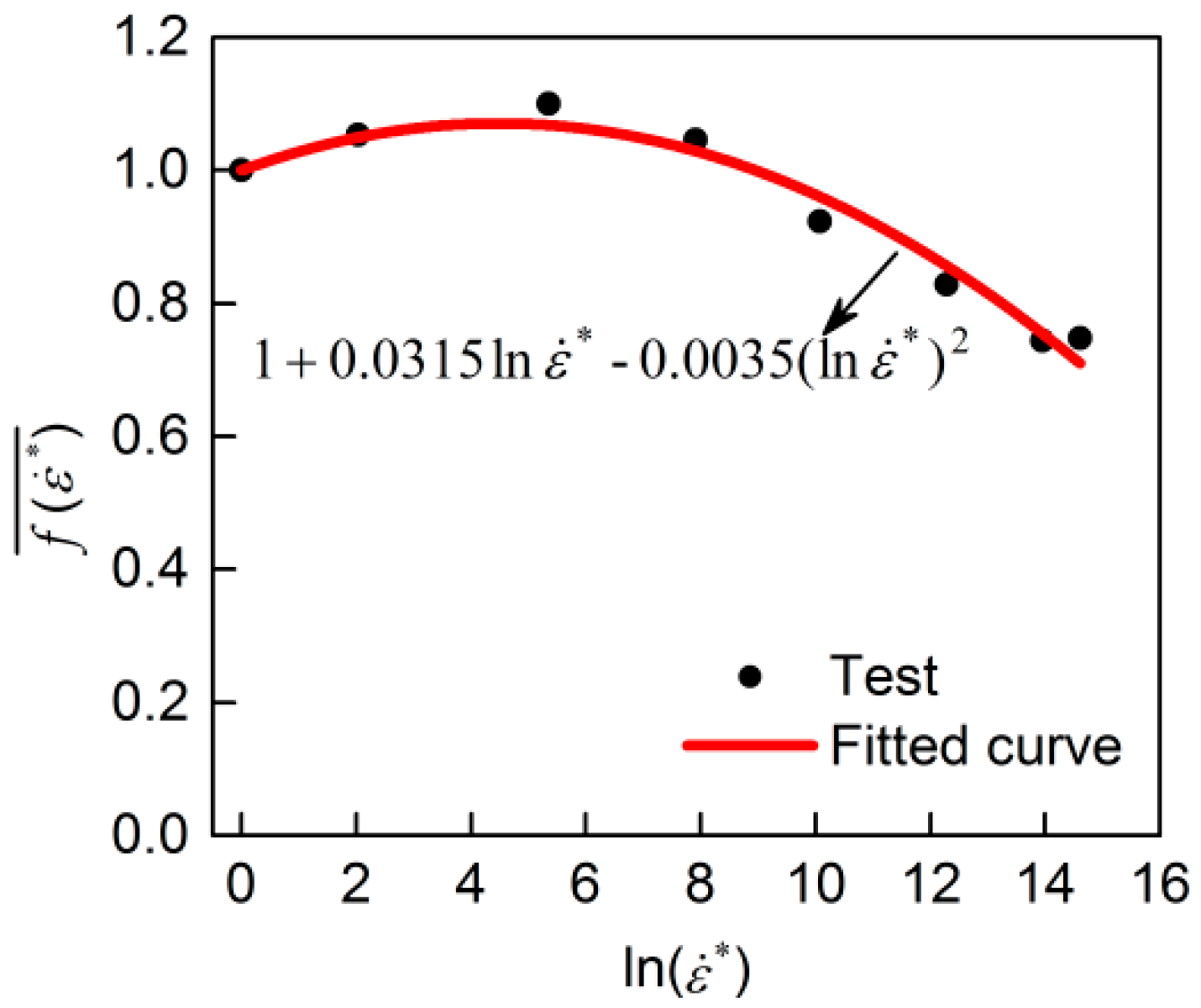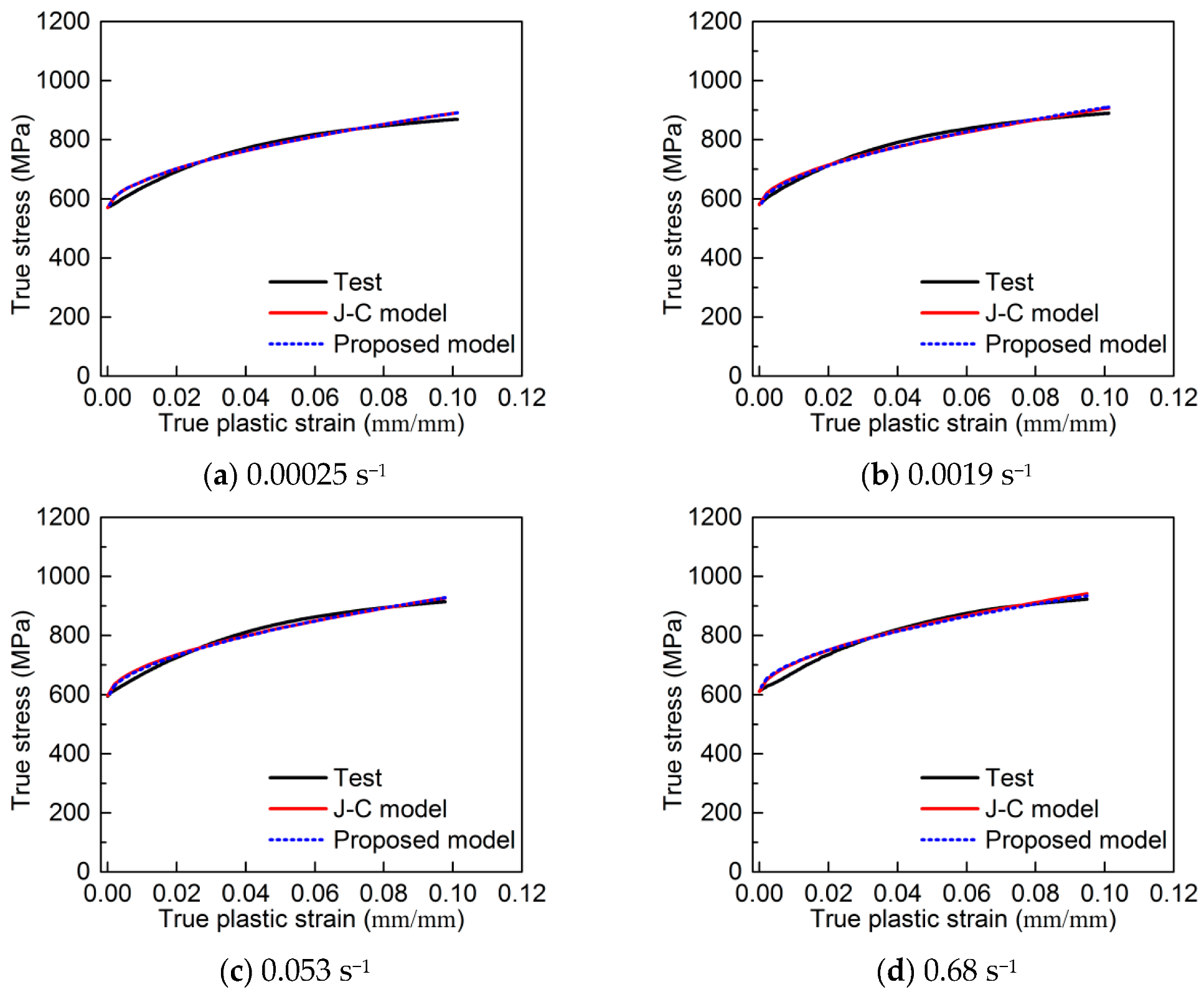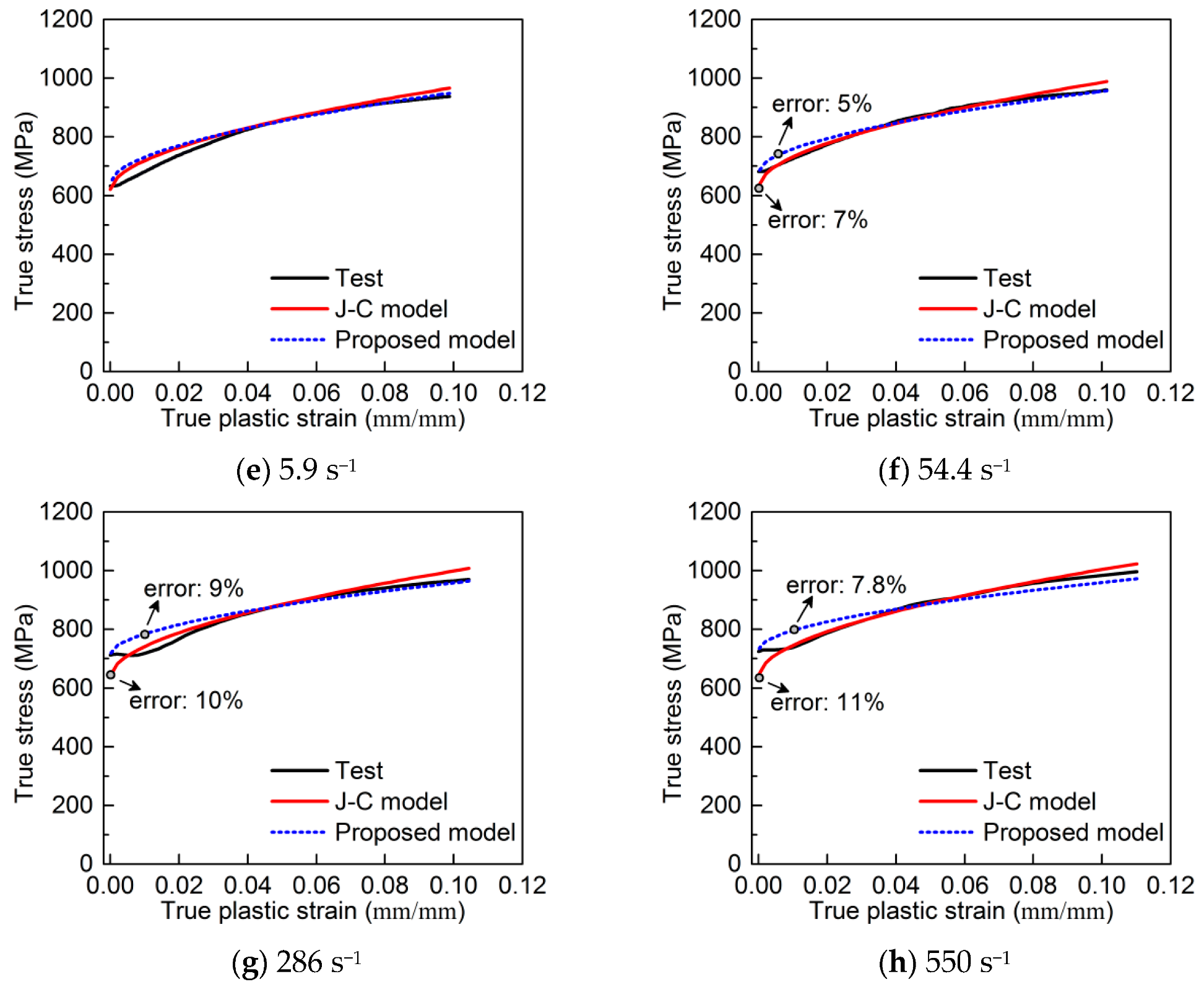4.1. Comparison of DIFs among Test Results on 500 MPa-Grade Reinforcing Bars
DIFs for yield stress and ultimate tensile strength versus strain rate curves of HRB500E steel are depicted in
Figure 6. Meanwhile, the existing test results of 500 MPa-grade hot-rolled ribbed bar (HRB500) [
15] and cold-worked reinforcing bar (B500A) [
16] are also shown in
Figure 6 for comparison. The figure indicates that the DIF
y is larger than DIF
t (DIF for ultimate tensile strength). That means that the yield stress is more sensitive to strain rate than the ultimate tensile strength.
In
Figure 6a, it is seen that DIF
y of B500A steel is lower than the DIF
y of HRB500E and HRB500 steel in the range of test strain rates. While B500A steel bar is cold-worked steel from hot-rolled wire rod and available as coils or bars with lower strength than 500 MPa, HRB500E and HRB500 steel bars are hot rolled. Cold work leads to microstructural changes in the crystal lattice, including increased dislocation density and changed grain size distributions, which results in an increase in yield strength and a decrease in ductility. Therefore, the different chemical compositions and microstructures are mainly responsible for the discrepancy of the dynamic behaviors among them.
Although it is observed that the DIF
y of HRB500E steel is very close to the DIF
y of HRB500 steel in the limited range of test strain rates, the trends of DIF
y between HRB500E and HRB500 with increasing strain rate seem to be different over a wider strain rate range. From the aspect of quasi-static behavior, it has been known that the HRB500E reinforcing bar developed for improving anti-earthquake performance of RC structures has higher ductility than HRB500 reinforcing bar [
1]. In addition, the chemical compositions and microstructures are distinct between them. Due to the lack of sufficient dynamic tensile test data of HRB500 steel, it remains pending whether the DIF
y of HRB500E steel is close to the DIF
y of HRB500 steel over a wide strain rate range.
Figure 6b shows that the difference in DIF
t among HRB500E, HRB500, and B500A steel is limited in the test strain rate range. The maximum difference of DIF
t between them is less than 5%. However, it is observed that the trends of DIF
t with strain rate increase are different among them.
4.2. Comparison of DIFs between Test Results and Existing Models
Several existing models [
7,
15,
16,
17,
21,
22] are employed to predict the DIF
y and DIF
t of HRB500E steel. The Cowper-Symonds (C-S) model [
21], a common and widely used model for DIF
y, is described as:
where
fsy and
fdy are quasi-static and dynamic yield stress, respectively, and
is strain rate. For mild steel, material coefficients
q and
D are 5 and 40.4, respectively [
21]. For high tensile steel,
D and
q are taken as 3200 and 5, respectively [
22]. For B500A steel, three groups of
D and
q were obtained, which are corresponding to the three different types of rebars (
d = 6, 8, 10 mm) tested by Cadoni et al. [
16]. It is found that the DIF
y predicted by C-S models with the three groups of
D and
q are close to each other, and the DIF
y from
D and
q for
d = 8 mm is almost the average value of the DIF
y from the three groups of
D and
q. Thus,
D = 25,361 and
q = 2.519 for B500A steel bar with a diameter of 8 mm [
16] were adopted to calculate the DIF
y of HRB500E steel, as shown in
Figure 6a.
Based on the dynamic tensile test results of reinforcing bars with quasi-static yield stress between 290 and 710 MPa, Malvar [
7] proposed the following formulations for DIF
y and DIF
t:
where for yield stress,
α =
αy:
and for ultimate tensile strength,
α =
αt:
In Equation (2), the denominator 10
−4 means the quasi-static strain rate with the unit s
−1. The test strain rate ranges from 10
−4 to 10 s
−1 for formulations (2)–(4). Moreover, the formulations (2)–(4) have been introduced into Model Code 2010 [
9] and are applied to a wider strain rate range of 10
−4 to 10
3 s
−1, whereas there is no sufficient test data supporting the application at a strain rate lager than 10 s
−1.
The Comité Euro-International du Béton (CEB) Bulletin 187 [
17] provided the formulations for DIF
y and DIF
t with the general form:
where
is quasi-static strain rate (
= 0.00001 s
−1),
f =
fsy for DIF
y, and
f =
fst for DIF
t. The parameter
m has different values for different reinforcing bars. For the hot-rolled reinforcing bar with 500 MPa grade,
m =
my = 5.1 for DIF
y and
m =
mt = 6.4 for DIF
t. The formulations and parameter were acquired on the basis of the test results of reinforcing bars under strain rates lower than 10 s
−1. In Reference [
15],
is taken as 0.0003 s
−1,
my and
mt were calibrated to be 9.72 and 7.78 for HRB500 steel, respectively, based on the tensile test results of HRB500 at intermediate strain rates between 5.2 and 54.2 s
−1.
The comparison of DIF
y and DIF
t between the test results and the aforementioned models [
7,
15,
16,
17,
21,
22] is presented in
Figure 6. In
Figure 6a, it is shown that the C-S model in [
16,
21,
22] overestimates or underestimates the DIF
y due to the inappropriate values of
q and
D for HRB500E. However, its nonlinear characteristic of DIF
y with increasing logarithmic strain rate is similar with that of HRB500E steel. The C-S model is needed to be calibrated for precisely predicting the DIF
y of HRB500E.
In a limited strain rate range such as from 10
−4 to 10 s
−1 or from 10 to 550 s
−1, approximate linear relationships between DIF
y and logarithmic strain rate for HRB500E are observed in
Figure 6a. However, the relationship is evidently nonlinear over the wider range from low to high strain rate. Equations (2)–(5) [
7,
15,
17] proposed on the basis of the test results in limited-strain-rate ranges describe the linear relationships, which are against the nonlinear tendency of DIF
y with increasing logarithmic strain rate. Therefore, the formulations are unsuitable for predicting the DIF
y of HRB500E in large strain rate range, as shown in
Figure 6a. Moreover, it is worth further discussing whether it is rational for Equations (2)–(4) to be applied to the strain rate range larger than 10 s
−1 by Mode Code 2010 [
9] in the absence of sufficient test data over a wide-strain-rate range.
As shown in
Figure 6b, Equations (2)–(4) [
7] and Equation (5) [
15,
17] seem to be suitable for predicting DIF
t for HRB500E. A comparison of DIF
t predicted by the existing models was shown in
Table 4, which indicates that the predicted results from the different models are in good agreement with test results.
4.3. Calibration of Models for DIFy
For better predicting the dynamic yield stress, the widely used C-S model and Malvar model were calibrated. New values of material coefficients q and D in C-S model and m in Malvar model can be obtained by fitting the models with test data.
In order to fit the C-S model conveniently, Equation (1) was transformed into Equation (6). The relationship between ln(
) and ln(DIF
y-1) is demonstrated in
Figure 7a. Through the linear fitting method,
D = 264,713 and
q = 4.906 were determined.
Figure 6a illustrates that the modified C-S model (listed in
Table 5) has high prediction accuracy for DIF
y with the largest error of 1.5%.
For the Malvar model (Equation (2)), the denominator 10
−4 s
−1 in Equation (2), representing the quasi-static strain rate
, is substituted by
= 0.00025 s
−1 in this study. Transforming Equation (2) into Equation (7), it was found that the relationship between ln(
) and ln(DIF
y) is nonlinear according to the test results, which indicates that parameter
αy is non-constant. From Equation (7),
αy can be expressed by Equation (8). Based on the test data,
αy was calculated by using Equation (8), and then was depicted as the increasing
in
Figure 7b. Through linearly fitting the relation of
αy to
as shown in
Figure 7b, the expression of
αy (Equation (9)) was acquired, where
αy is quite different from the constant in the previous model. As shown in
Figure 6a, the values for DIF
y predicted by the modified Malvar model with Equation (9) (listed in
Table 5) have a good agreement with the test DIF
y with the largest error of 1.8%.
